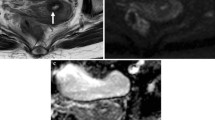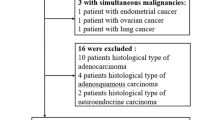Abstract
Objective
To investigate the value of diffusion-weighted imaging (DWI) in evaluating parametrial invasion (PMI) in stage IA2–IIA cervical cancer.
Methods
A total of 117 patients with stage IA2–IIA cervical cancer who underwent preoperative MRI and radical hysterectomy were included in this study. Preoperative clinical variables and MRI variables were analysed and compared between the groups with and without pathologically proven PMI.
Results
All variables except age were significantly different between patients with and without pathologic PMI (P < 0.05). All variables except squamous cell carcinoma (SCC) antigen were also significantly correlated with pathologic PMI on univariate analysis (P < 0.05). Multivariate analysis indicated that PMI on MRI (P < 0.001) and tumour apparent diffusion coefficient (ADC) (P = 0.029) were independent predictors of pathologic PMI. Area under the curve of PMI on MRI increased significantly from 0.793 to 0.872 when combined with tumour ADC (P = 0.002). When PMI on MRI was further stratified by tumour ADC, the false negative rate was 2.0 % (1/49).
Conclusion
In stage IA2–IIA cervical cancer, tumour ADC and PMI on MRI seem to be independent predictors of pathologic PMI. Combining the two predictors improved the diagnostic performance of identifying patients at low risk of pathologic PMI.
Key points
• Accurate PMI prediction is essential for appropriate treatment planning
• Tumour ADC appears to be an independent predictor of pathologic PMI
• Adding DWI to MRI improves accuracy for identifying low-risk patients for PMI



Similar content being viewed by others
Abbreviations
- ADC:
-
Apparent diffusion coefficient
- AUC:
-
Area under the curve
- CI:
-
Confidence interval
- DWI:
-
Diffusion-weighted imaging
- FIGO:
-
International Federation of Gynecology and Obstetrics
- FOV:
-
Field of view
- LN:
-
Lymph node
- MRI:
-
Magnetic resonance imaging
- OR:
-
Odds ratio
- PMI:
-
Parametrial invasion
- ROC:
-
Receiver operating characteristics
- ROI:
-
Region of interest
- SCC:
-
Squamous cell carcinoma
- T2WI:
-
T2-weighted imaging
References
Delgado G, Bundy BN, Fowler WC Jr et al (1989) A prospective surgical pathological study of stage I squamous carcinoma of the cervix: a Gynecologic Oncology Group Study. Gynecol Oncol 35:314–320
Landoni F, Bocciolone L, Perego P, Maneo A, Bratina G, Mangioni C (1995) Cancer of the cervix, FIGO stages IB and IIA: patterns of local growth and paracervical extension. Int J Gynecol Cancer 5:329–334
Zullo MA, Manci N, Angioli R, Muzii L, Panici PB (2003) Vesical dysfunctions after radical hysterectomy for cervical cancer: a critical review. Crit Rev Oncol Hematol 48:287–293
Raspagliesi F, Ditto A, Fontanelli R et al (2006) Type II versus Type III nerve-sparing radical hysterectomy: comparison of lower urinary tract dysfunctions. Gynecol Oncol 102:256–262
Kodama J, Kusumoto T, Nakamura K, Seki N, Hongo A, Hiramatsu Y (2011) Factors associated with parametrial involvement in stage IB1 cervical cancer and identification of patients suitable for less radical surgery. Gynecol Oncol 122:491–494
Chang SJ, Bristow RE, Ryu HS (2012) A model for prediction of parametrial involvement and feasibility of less radical resection of parametrium in patients with FIGO stage IB1 cervical cancer. Gynecol Oncol 126:82–86
Gemer O, Eitan R, Gdalevich M et al (2013) Can parametrectomy be avoided in early cervical cancer? An algorithm for the identification of patients at low risk for parametrial involvement. Eur J Surg Oncol 39:76–80
Thomeer MG, Gerestein C, Spronk S, van Doorn HC, van der Ham E, Hunink MG (2013) Clinical examination versus magnetic resonance imaging in the pretreatment staging of cervical carcinoma: systematic review and meta-analysis. Eur Radiol 23:2005–2018
Pecorelli S, Zigliani L, Odicino F (2009) Revised FIGO staging for carcinoma of the cervix. Int J Gynaecol Obstet 105:107–108
Wakefield JC, Downey K, Kyriazi S, deSouza NM (2013) New MR techniques in gynecologic cancer. AJR Am J Roentgenol 200:249–260
Thoeny HC, Forstner R, De Keyzer F (2012) Genitourinary applications of diffusion-weighted MR imaging in the pelvis. Radiology 263:326–342
Nougaret S, Tirumani SH, Addley H, Pandey H, Sala E, Reinhold C (2013) Pearls and pitfalls in MRI of gynecologic malignancy with diffusion-weighted technique. AJR Am J Roentgenol 200:261–276
Downey K, Riches SF, Morgan VA et al (2013) Relationship between imaging biomarkers of stage I cervical cancer and poor-prognosis histologic features: quantitative histogram analysis of diffusion-weighted MR images. AJR Am J Roentgenol 200:314–320
Kuang F, Ren J, Zhong Q, Liyuan F, Huan Y, Chen Z (2013) The value of apparent diffusion coefficient in the assessment of cervical cancer. Eur Radiol 23:1050–1058
Payne GS, Schmidt M, Morgan VA et al (2010) Evaluation of magnetic resonance diffusion and spectroscopy measurements as predictive biomarkers in stage 1 cervical cancer. Gynecol Oncol 116:246–252
Jung DC, Kim MK, Kang S et al (2010) Identification of a patient group at low risk for parametrial invasion in early-stage cervical cancer. Gynecol Oncol 119:426–430
Kamimori T, Sakamoto K, Fujiwara K et al (2011) Parametrial involvement in FIGO stage IB1 cervical carcinoma diagnostic impact of tumor diameter in preoperative magnetic resonance imaging. Int J Gynecol Cancer 21:349–354
Kim HS, Kim CK, Park BK, Huh SJ, Kim B (2013) Evaluation of therapeutic response to concurrent chemoradiotherapy in patients with cervical cancer using diffusion-weighted MR imaging. J Magn Reson Imaging 37:187–193
Choi SH, Kim SH, Choi HJ, Park BK, Lee HJ (2004) Preoperative magnetic resonance imaging staging of uterine cervical carcinoma: results of prospective study. J Comput Assist Tomogr 28:620–627
Youden WJ (1950) Index for rating diagnostic tests. Cancer 3:32–35
Hricak H, Lacey CG, Sandles LG, Chang YC, Winkler ML, Stern JL (1988) Invasive cervical carcinoma: comparison of MR imaging and surgical findings. Radiology 166:623–631
Sironi S, De Cobelli F, Scarfone G et al (1993) Carcinoma of the cervix: value of plain and gadolinium-enhanced MR imaging in assessing degree of invasiveness. Radiology 188:797–801
Hawighorst H, Knapstein PG, Weikel W et al (1996) Cervical carcinoma: comparison of standard and pharmacokinetic MR imaging. Radiology 201:531–539
Sheu M, Chang C, Wang J, Yen M (2001) MR staging of clinical stage I and IIa cervical carcinoma: a reappraisal of efficacy and pitfalls. Eur J Radiol 38:225–231
Harry VN (2010) Novel imaging techniques as response biomarkers in cervical cancer. Gynecol Oncol 116:253–261
Naganawa S, Sato C, Kumada H, Ishigaki T, Miura S, Takizawa O (2005) Apparent diffusion coefficient in cervical cancer of the uterus: comparison with the normal uterine cervix. Eur Radiol 15:71–78
Chopra S, Verma A, Kundu S et al (2012) Evaluation of diffusion-weighted imaging as a predictive marker for tumor response in patients undergoing chemoradiation for postoperative recurrences of cervical cancer. J Cancer Res Ther 8:68–73
Nakamura K, Joja I, Nagasaka T et al (2012) The mean apparent diffusion coefficient value (ADCmean) on primary cervical cancer is a predictive marker for disease recurrence. Gynecol Oncol 127:478–483
Choi HJ, Kim SH, Seo SS et al (2006) MRI for pretreatment lymph node staging in uterine cervical cancer. AJR Am J Roentgenol 187:W538–W543
Choi EK, Kim JK, Choi HJ et al (2009) Node-by-node correlation between MR and PET/CT in patients with uterine cervical cancer: diffusion-weighted imaging versus size-based criteria on T2WI. Eur Radiol 19:2024–2032
Acknowledgements
The scientific guarantor of this publication is Chan Kyo Kim, MD. The authors of this manuscript declare no relationships with any companies whose products or services may be related to the subject matter of the article. This study did not receive any funds. The institutional review board of our hospital approved this retrospective study. The requirement for informed consent was waived due to the retrospective nature of the study. Approval from the institutional animal care committee was not required because this study was on human subjects. None of the study subjects or cohorts have been previously reported in any studies. All co-authors have approved the publication. The responsible authorities and guarantor at the institute have carried out the work. All material submitted (including intellectual property and illustration elements) originated from the authors. The authors take responsibility for accuracy and completeness of references and copyright permissions. Sookyoung Woo, PhD kindly provided statistical advice for this manuscript. The authors thank Sookyoung Woo, PhD, at Samsung Biomedical Research Institute for help in statistical consultation. Methodology: retrospective, diagnostic or prognostic study, performed at one institution
Author information
Authors and Affiliations
Corresponding author
Rights and permissions
About this article
Cite this article
Park, J.J., Kim, C.K., Park, S.Y. et al. Value of diffusion-weighted imaging in predicting parametrial invasion in stage IA2–IIA cervical cancer. Eur Radiol 24, 1081–1088 (2014). https://doi.org/10.1007/s00330-014-3109-x
Received:
Revised:
Accepted:
Published:
Issue Date:
DOI: https://doi.org/10.1007/s00330-014-3109-x




